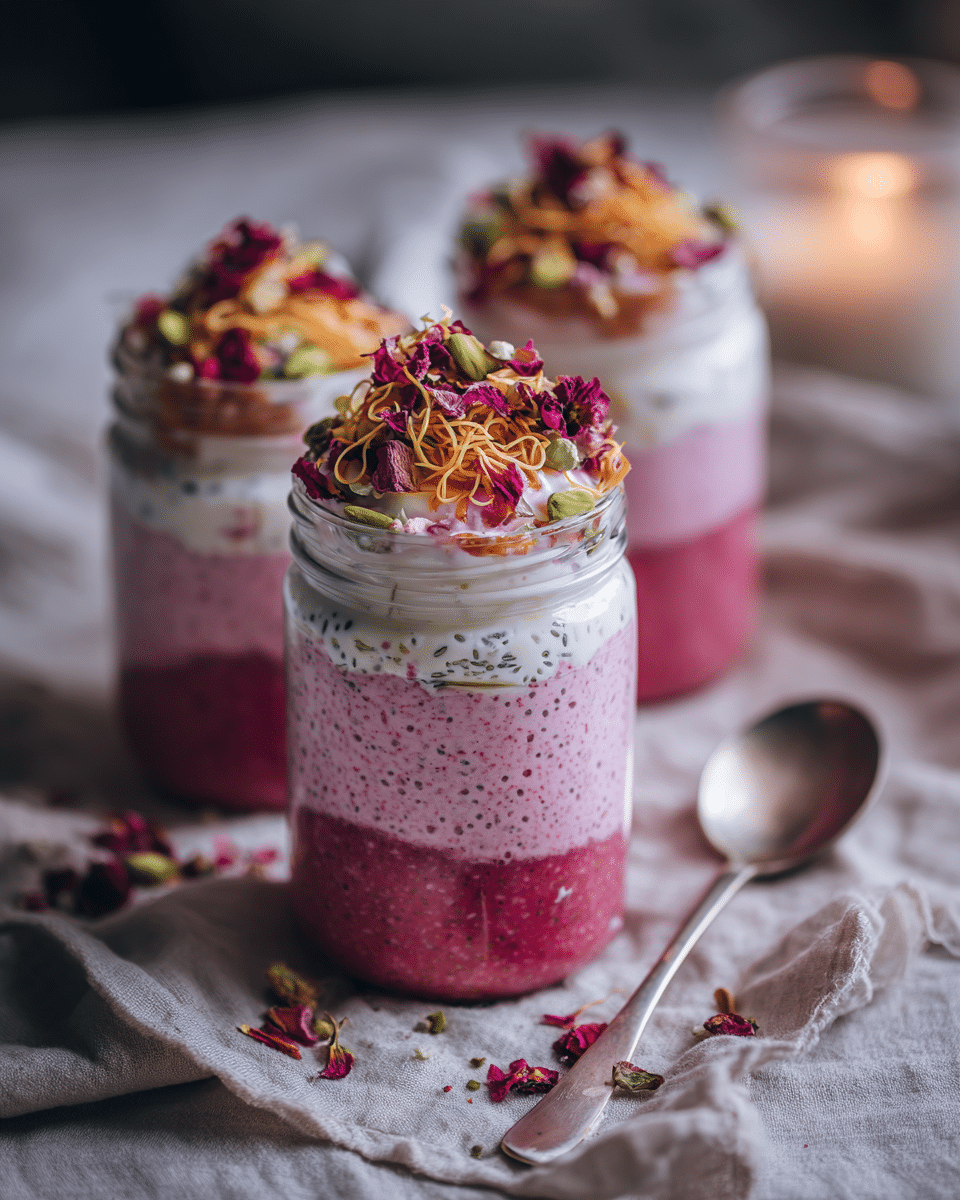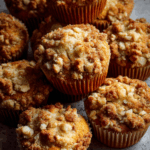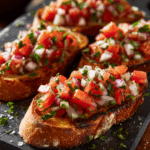Rabri Falooda is a classic Indian dessert that combines rich, creamy rabri with colorful, textured falooda noodles, rose syrup, and nuts for an indulgent, layered treat. Served chilled in individual jars, this dessert is as visually stunning as it is delicious. Perfect for special occasions or warm weather, Rabri Falooda offers a delightful blend of creamy, floral, and nutty flavors with a refreshing chill, making it a show-stopping finale to any meal.
FULL RECIPE
Ingredients
- 1 liter whole milk
- 1/2 cup sugar
- 1/4 teaspoon cardamom powder
- 1 tablespoon chopped pistachios
- 1 tablespoon chopped almonds
- 1/4 cup basil seeds (sabja seeds)
- 1/2 cup falooda sev (vermicelli-like noodles made from cornstarch)
- 1/2 cup rose syrup
- 1 cup chilled water
- 1/2 cup chilled sweetened condensed milk
- 1/4 cup chopped fresh fruits (optional, like mango or strawberry)
- A few strands of saffron (optional)
- 1/2 cup vanilla ice cream (optional)
Directions
- To prepare rabri, bring the milk to a boil in a heavy-bottomed pan, stirring occasionally to prevent burning.
- Lower the heat and simmer the milk gently, stirring often, until it thickens to a creamy consistency (about 45 minutes to 1 hour). Add sugar, cardamom powder, and saffron strands if using, and stir well. Remove from heat and let it cool.
- Soak basil seeds in chilled water for 20 minutes until they swell and become gelatinous. Drain and set aside.
- Cook falooda sev in boiling water for 2-3 minutes until soft. Drain, rinse under cold water, and set aside.
- To assemble the jars, start by spooning a layer of chilled rabri at the bottom.
- Add a layer of soaked basil seeds followed by a spoonful of falooda sev.
- Drizzle rose syrup over the sev layer to add sweetness and color.
- Add a layer of chopped nuts and fresh fruits if using.
- Pour a little sweetened condensed milk on top for extra richness.
- Repeat the layers if your jar is tall enough, ending with a final dollop of rabri on top.
- Garnish with chopped pistachios and almonds. Optionally, add a scoop of vanilla ice cream before serving for an extra indulgent touch.
- Chill the jars in the refrigerator for at least an hour before serving to let the flavors meld and the dessert cool thoroughly.
Nutrition Facts
- Calories: 320
- Total Fat: 15g
- Saturated Fat: 9g
- Cholesterol: 40mg
- Sodium: 60mg
- Total Carbohydrates: 38g
- Dietary Fiber: 2g
- Sugars: 30g
- Protein: 8g
History and Cultural Significance of Rabri Falooda
Rabri Falooda is a beloved dessert with roots in the Indian subcontinent, where it has been enjoyed for centuries during festivals and special occasions. Rabri, a thickened milk delicacy, pairs beautifully with falooda, which are delicate, translucent noodles made from cornstarch or wheat starch. This combination, often enhanced with fragrant rose syrup and nuts, reflects a rich tradition of layered desserts that celebrate texture, flavor, and visual appeal. In many families, serving Rabri Falooda is synonymous with hospitality and celebration, making it a dessert that carries both culinary and emotional significance.
The Role of Rabri in the Dessert
Rabri forms the creamy, indulgent base of this dessert. It is made by slow-cooking milk to reduce and thicken it, concentrating its flavors and creating a luscious texture. The slow simmering also infuses the rabri with cardamom and saffron notes, adding aromatic warmth. Its richness balances the lighter, more refreshing components of falooda and rose syrup, creating a harmonious blend of textures and tastes. The creamy, slightly grainy nature of rabri adds a luxurious mouthfeel that defines the dessert’s character.
Understanding Falooda Sev and Its Texture
Falooda sev are thin noodles traditionally made from cornflour or arrowroot starch, cooked quickly to achieve a soft, slippery texture. These noodles contribute a unique chewy contrast that adds dimension to the dessert. Their translucent appearance lends visual intrigue to the layers, making the dessert not only tasty but also visually enticing. In modern adaptations, different types of noodles or even vermicelli are sometimes used, but authentic falooda sev remains a prized ingredient for maintaining the dish’s traditional texture.
The Importance of Basil Seeds (Sabja Seeds)
Basil seeds, also known as sabja seeds, are a distinctive feature in Rabri Falooda that elevate the dessert’s sensory experience. When soaked in water, they swell and develop a gelatinous coating that offers a refreshing, cooling effect in the mouth. They are often mistaken for chia seeds but have a milder taste. Beyond texture, basil seeds also bring nutritional benefits, including fiber and antioxidants, adding a subtle health boost to this indulgent treat. Their presence balances the richness of rabri with a light, refreshing element.
Flavor Enhancers: Rose Syrup and Cardamom
Rose syrup is essential in imparting the floral sweetness and signature pink hue of the dessert, evoking traditional flavors loved across South Asia. Its fragrant aroma enhances the sensory appeal and adds a delicate sweetness that ties the layers together. Cardamom, often added to the rabri, offers a warm, spicy undertone that complements the rose without overpowering it. Together, these flavors create a complex but balanced profile that is both exotic and comforting.
Nutty Crunch: The Role of Pistachios and Almonds
Chopped pistachios and almonds add a vital crunchy texture and a nutty richness that contrasts with the softness of rabri and falooda sev. Nuts also provide additional nutrients, such as healthy fats, protein, and vitamins, subtly enhancing the dessert’s nutritional profile. Their inclusion elevates the overall eating experience by adding complexity and a luxurious finish. Toasting the nuts lightly before garnishing can deepen their flavor and provide an even more satisfying crunch.
Serving Suggestions and Presentation Tips
Rabri Falooda is best served chilled, making it a perfect treat for warm weather or festive celebrations. Presenting the dessert in clear glass jars or tall glasses allows the beautiful layers to shine through, enhancing its visual appeal. Garnishing with saffron strands, additional chopped nuts, or a scoop of vanilla ice cream adds elegance and indulgence. For a fresh touch, adding seasonal fruits such as mangoes or strawberries can introduce a pop of color and complement the sweet, creamy layers.
Variations and Creative Twists
While traditional Rabri Falooda is beloved, many variations exist to suit different tastes and dietary preferences. Some recipes swap the rose syrup for other flavored syrups like kewra or mango. Vegan versions substitute dairy rabri with coconut or almond milk-based creams. For added texture, ingredients like jelly cubes, fruit pearls, or even chia seeds can be included. These variations allow home cooks and chefs alike to experiment while honoring the spirit of the original recipe.
Nutritional Insights and Health Considerations
Rabri Falooda is rich and indulgent, providing a good source of protein and calcium from the milk and nuts, but it is also high in sugar and saturated fat. Moderation is key to enjoying this dessert as part of a balanced diet. Using low-fat milk or reducing added sugar can make the dessert slightly lighter. The inclusion of basil seeds and nuts adds fiber and healthy fats, which can aid digestion and provide sustained energy. For health-conscious eaters, portion control and mindful ingredient substitutions are recommended.
Storage and Shelf Life Tips
Due to its dairy base, Rabri Falooda is best consumed fresh but can be stored in the refrigerator for up to two days. It is advisable to keep the components separate if possible, especially the falooda sev, to maintain their texture. Assembling just before serving helps preserve the freshness and prevents sogginess. Avoid freezing, as this can alter the texture of milk and basil seeds negatively. Proper airtight storage prevents the dessert from absorbing other fridge odors and maintains its delicate flavors.
Advertisement
Pairing Rabri Falooda with Other Dishes
Rabri Falooda makes a perfect finale to rich, spicy meals commonly found in Indian and Pakistani cuisines. Its cool, sweet profile helps balance the heat and complexity of savory dishes such as biryanis, kebabs, and curries. It can also be paired with lighter snacks like samosas or pakoras for an afternoon tea spread. The dessert’s refreshing quality complements strong chai or mild coffee, creating a satisfying meal experience from start to finish.
Conclusion
Rabri Falooda jars are a celebration of texture, flavor, and tradition wrapped into one beautiful, chilled dessert. Their layered nature offers a delightful combination of creamy rabri, chewy falooda sev, fragrant rose syrup, and crunchy nuts, making every bite a sensory experience. Versatile in presentation and open to creative variations, this dessert remains a favorite across generations and regions.






